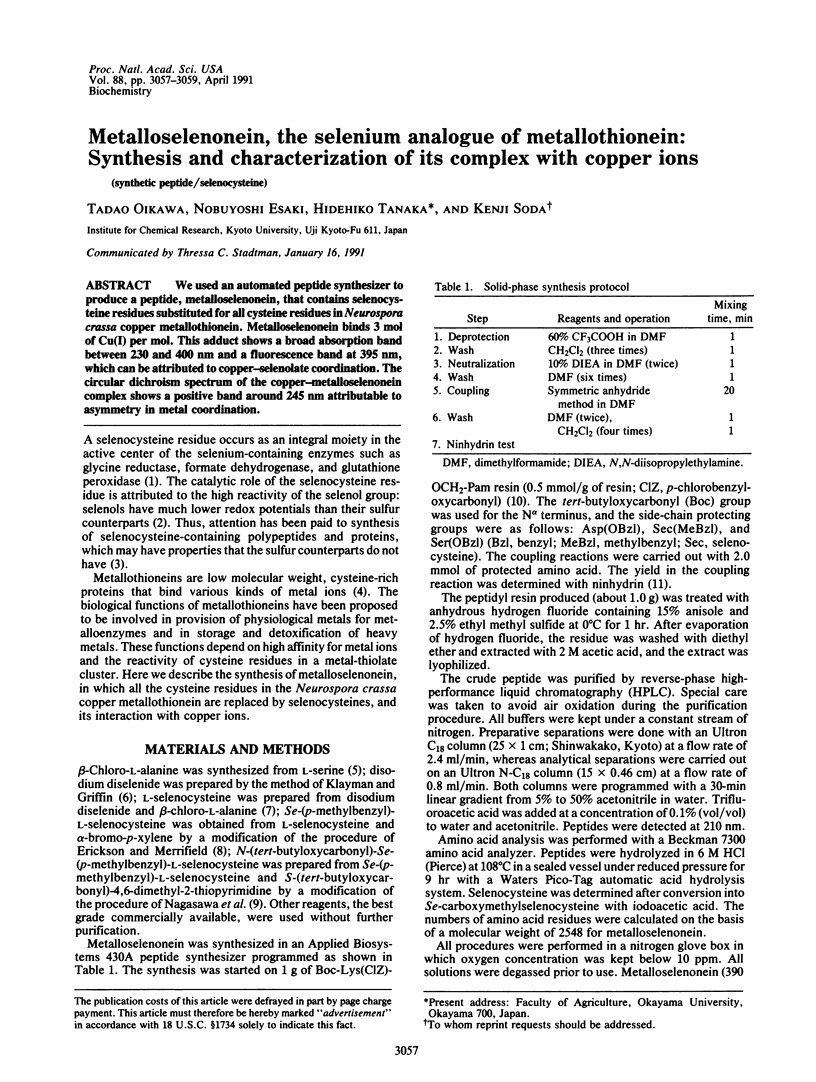Abstract
We used an automated peptide synthesizer to produce a peptide, metalloselenonein, that contains selenocysteine residues substituted for all cysteine residues in Neurospora crassa copper metallothionein. Metalloselenonein binds 3 mol of Cu(I) per mol. This adduct shows a broad absorption band between 230 and 400 nm and a fluorescence band at 395 nm, which can be attributed to copper-selenolate coordination. The circular dichroism spectrum of the copper-metalloselenonein complex shows a positive band around 245 nm attributable to asymmetry in metal coordination.
Full text
PDF


Selected References
These references are in PubMed. This may not be the complete list of references from this article.
- Chocat P., Esaki N., Tanaka H., Soda K. Synthesis of L-selenodjenkolate and its degradation with methionine gamma-lyase. Anal Biochem. 1985 Aug 1;148(2):485–489. doi: 10.1016/0003-2697(85)90256-8. [DOI] [PubMed] [Google Scholar]
- Coch E. H., Greene R. C. The utilization of selenomethionine by Escherichia coli. Biochim Biophys Acta. 1971 Feb 23;230(2):223–236. doi: 10.1016/0304-4165(71)90207-8. [DOI] [PubMed] [Google Scholar]
- Cone J. E., Del Río R. M., Davis J. N., Stadtman T. C. Chemical characterization of the selenoprotein component of clostridial glycine reductase: identification of selenocysteine as the organoselenium moiety. Proc Natl Acad Sci U S A. 1976 Aug;73(8):2659–2663. doi: 10.1073/pnas.73.8.2659. [DOI] [PMC free article] [PubMed] [Google Scholar]
- Erickson B. W., Merrifield R. B. Use of chlorinated benzyloxycarbonyl protecting groups to eliminate N -branching at lysine during solid-phase peptide synthesis. J Am Chem Soc. 1973 May 30;95(11):3757–3763. doi: 10.1021/ja00792a047. [DOI] [PubMed] [Google Scholar]
- Fee J. A., Palmer G. The properties of parsley ferredoxin and its selenium-containing homolog. Biochim Biophys Acta. 1971 Aug 6;245(1):175–195. doi: 10.1016/0005-2728(71)90020-x. [DOI] [PubMed] [Google Scholar]
- Lerch K. Copper metallothionein, a copper-binding protein from Neurospora crassa. Nature. 1980 Mar 27;284(5754):368–370. doi: 10.1038/284368a0. [DOI] [PubMed] [Google Scholar]
- Merrifield B. Solid phase synthesis. Science. 1986 Apr 18;232(4748):341–347. doi: 10.1126/science.3961484. [DOI] [PubMed] [Google Scholar]
- Meyer J., Moulis J. M. Replacement of sulfide by selenide in the [4Fe-4S] clusters of the ferredoxin from Clostridium pasteurianum. Biochem Biophys Res Commun. 1981 Nov 30;103(2):667–673. doi: 10.1016/0006-291x(81)90502-7. [DOI] [PubMed] [Google Scholar]
- Mitchell A. R., Erickson B. W., Ryabtsev M. N., Hodges R. S., Merrifield R. B. Tert-butoxycarbonylaminoacyl-4-(oxymethyl)-phenylacetamidomethyl-resin, a more acid-resistant support for solid-phase peptide synthesis. J Am Chem Soc. 1976 Nov 10;98(23):7357–7362. doi: 10.1021/ja00439a041. [DOI] [PubMed] [Google Scholar]
- Sarin V. K., Kent S. B., Tam J. P., Merrifield R. B. Quantitative monitoring of solid-phase peptide synthesis by the ninhydrin reaction. Anal Biochem. 1981 Oct;117(1):147–157. doi: 10.1016/0003-2697(81)90704-1. [DOI] [PubMed] [Google Scholar]
- Stadtman T. C. Selenium-dependent enzymes. Annu Rev Biochem. 1980;49:93–110. doi: 10.1146/annurev.bi.49.070180.000521. [DOI] [PubMed] [Google Scholar]
- Theodoropoulos D., Schwartz I. L., Walter R. Synthesis of selenium-containing peptides. Biochemistry. 1967 Dec;6(12):3927–3932. doi: 10.1021/bi00864a039. [DOI] [PubMed] [Google Scholar]
- Walsh C. T., Schonbrunn A., Abeles R. H. Studies on the mechanism of action of D-amino acid oxidase. Evidence for removal of substrate -hydrogen as a proton. J Biol Chem. 1971 Nov 25;246(22):6855–6866. [PubMed] [Google Scholar]
- Walter R., Chan W. Y. Syntheses and pharmacological properties of selenium isologs of oxytocin and deamino-oxytocin. J Am Chem Soc. 1967 Jul 19;89(15):3892–3898. doi: 10.1021/ja00991a037. [DOI] [PubMed] [Google Scholar]
- Wilson G. S., Tsibris J. C., Gunsalus I. C. Electrochemical studies of putidaredoxin and its selenium analog. J Biol Chem. 1973 Sep 10;248(17):6059–6061. [PubMed] [Google Scholar]


